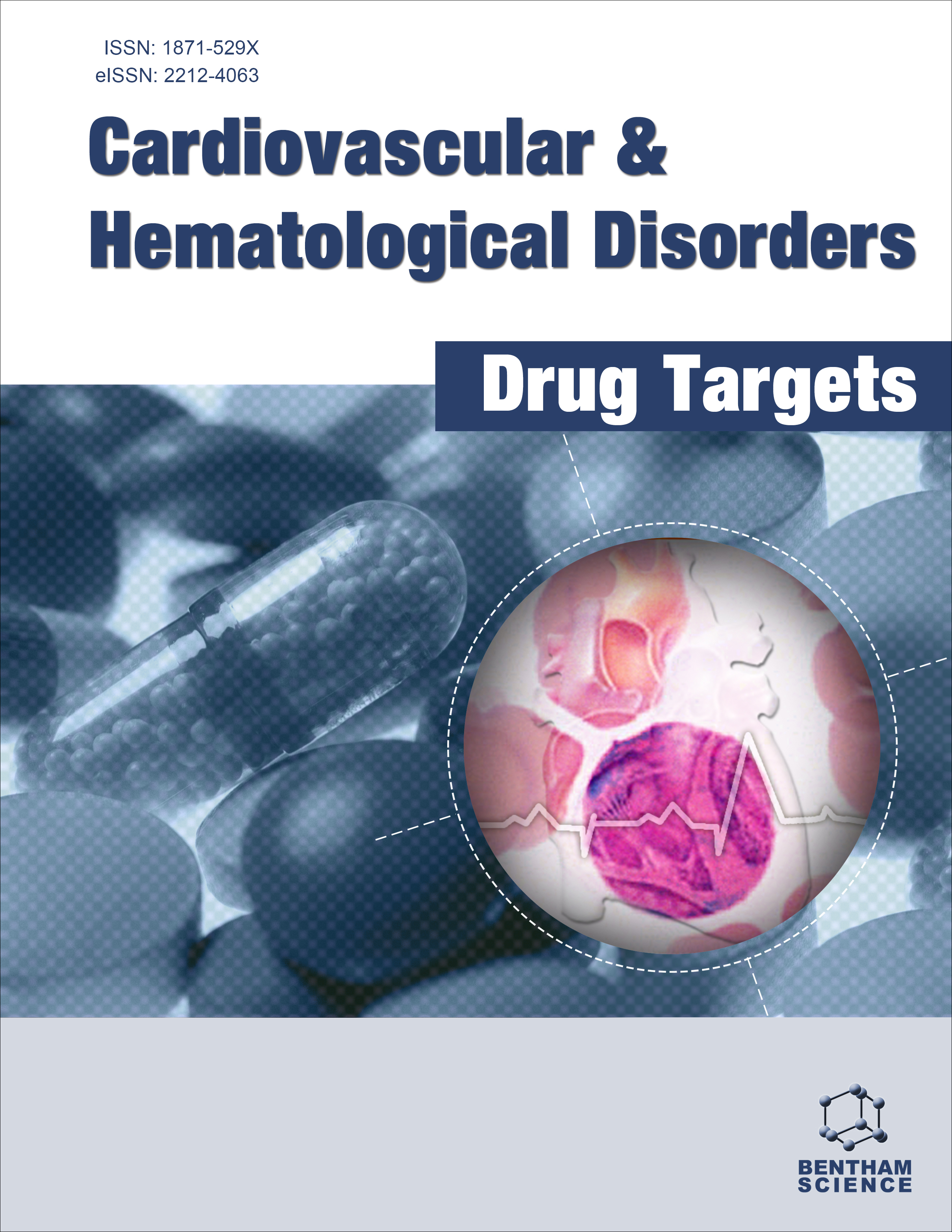- Home
- A-Z Publications
- Cardiovascular & Haematological Disorders - Drug Targets
- Previous Issues
- Volume 6, Issue 2, 2006
Cardiovascular & Haematological Disorders - Drug Targets - Volume 6, Issue 2, 2006
Volume 6, Issue 2, 2006
-
-
The Effects of Prostaglandin E-1 in Patients with Intermittent Claudication
More LessAuthors: Glauco Milio, Giuseppe Coppola and Salvatore NovoAim of the study is to evaluate the effects of Prostaglandin E-1 (PGE-1) in patients with peripheral arterial disease (PAD) at the 2nd b stage Fontaine's classification. The study, controlled, single blinded, enrolled 123 patients with intermittent claudication that were randomised in two groups; the first group received a treatment with PGE-1 while the second one received a pentoxifylline-buflomedil association by venous Read More
-
-
-
Prevention of Myocardial Damage During Coronary Intervention
More LessAuthors: Vincenzo Pasceri, Giuseppe Patti and Germano D. SciascioMyocardial injury during coronary intervention occurs in 10-40% of cases and is often characterized by a slight increase of markers of myocardial necrosis, without symptoms, electrocardiographic changes or impairment of cardiac function. However, even small increases of creatine kinase-MB levels are expression of a true and detectable infarction, and may be associated with higher follow-up mortality. The cause of CK-MB ele Read More
-
-
-
Cyclooxygenase-2 Inhibitors: A Painful Lesson
More LessNon-steroidal anti-inflammatory drugs (NSAIDs) represent a clinically important class of agents. NSAIDs are commonly used in treatment of conditions such as headache, fever, inflammation and joint pain. Complications often arise from chronic use of NSAIDs. Gastrointestinal (GI) toxicity in the form of gastritis, peptic erosions and ulcerations and GI bleeds limit usage of NSAIDs. These toxicities are thought to be due to cyc Read More
-
-
-
Regulatory Mechanisms of Cardiac Development and Repair
More LessAuthors: Ana Chinchilla and Diego FrancoThe heart originates from bilateral primordia that eventually fuse in the embryonic midline leading to a linear tube. Soon after, the heart bends to the right and atrial and ventricular chambers are formed. Progressively each embryonic compartment initiates a process of septation that eventually leads to a four chambered heart with a double circuitry and synchronous contraction. During these developmental events, th Read More
-
-
-
Inhibition of sPLA2-IIA, C-reactive Protein or Complement: New Therapy for Patients with Acute Myocardial Infarction?
More LessReperfusion of ischemic myocardium after acute myocardial infarction (AMI) induces a local activation of inflammatory reactions that results in ischemia/reperfusion (I/R)-injury. I/R-injury contributes considerably to the total cell damage in the heart after AMI. Secretory phospolipase A2-IIA (sPLA2-IIA), C-reactive protein (CRP) and complement are inflammatory mediators that have been demonstrated to play key roles in I/R Read More
-
-
-
Physiological Significance and Therapeutic Potential of Adrenomedullin in Pulmonary Hypertension
More LessAuthors: Shinsuke Murakami, Hiroshi Kimura, Kenji Kangawa and Noritoshi NagayaAdrenomedullin (ADM) is a potent vasodilator peptide that was originally isolated from human pheochromocytoma. Its vasodilatory effect is mediated by cyclic adenosine 3',5'-monophosphate- and nitric oxidedependent mechanisms. Earlier studies have demonstrated that ADM is secreted from various tissues, including vessels, heart, and lungs. In addition, there are specific receptors for ADM in the lungs. Plasma Read More
-
-
-
Uremia, Atherothrombosis and Malnutrition: The Role of L-arginine- Nitric Oxide Pathway
More LessThe uraemic syndrome is a complex condition that results from an accumulation of multiple waste compounds, combined with failure of the endocrine and homeostatic functions of the kidney in end-stage chronic renal failure (CRF) patients. Recently it has become clear that uraemia is a microinflammatory condition with a significant increase in inflammation markers. Malnutrition is a common pathological condition which Read More
-
Volumes & issues
-
Volume 24 (2024)
-
Volume 23 (2023)
-
Volume 22 (2022)
-
Volume 21 (2021)
-
Volume 20 (2020)
-
Volume 19 (2019)
-
Volume 18 (2018)
-
Volume 17 (2017)
-
Volume 16 (2016)
-
Volume 15 (2015)
-
Volume 14 (2014)
-
Volume 13 (2013)
-
Volume 12 (2012)
-
Volume 11 (2011)
-
Volume 10 (2010)
-
Volume 9 (2009)
-
Volume 8 (2008)
-
Volume 7 (2007)
-
Volume 6 (2006)
Most Read This Month
Article
content/journals/chddt
Journal
10
5
false
en


